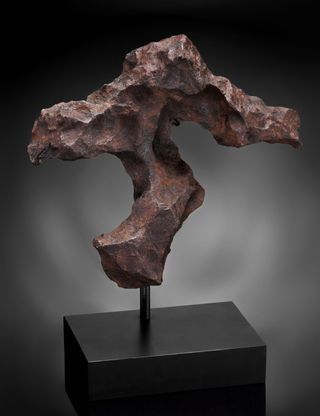Meteorites for Sale: Space-Rock Fans Swoon Over Moon (But Not Mars)

NEW YORK — Jonathan Siegel arrived at the meteorite auction yesterday (Oct. 14) with plans to buy his first rock from space. One particular meteorite topped his list: a 6.7-pound (3.1-kilogram) iron meteorite with an unusually bright red-orange patina.
"It looks a little different than the others," Siegel said before the auction began. "It's fascinating to me you can buy these things and they are not all in museums."
He and other potential buyers had plenty of choices. Auction house Heritage Auctions was offering for sale rocks from Mars and the moon, silver meteorite slices studded with peridot gems, a slice of the meteorite that killed a cow in Venezuela, the rear tail-light bulb and title to a car punctured by a meteorite, meteorite jewelry — more than 120 lots in total. This auction was a first for Heritage Auctions; in prior auctions, it has included meteorites other natural history collectibles, such as fossils. Heritage Auctions billed the event as the largest of its kind.
Meteorite browsing
Nearly all were on display beforehand in the mansion near Central Park where the auction was held. Siegel was among those perusing the meteorites and considering his budget.
Meteorites shaped into spheres caught the eye of another potential buyer, Wassief Boctor. [Photos of Meteorites For Sale]
"I can use them as paperweights, and besides they are cheap," he said, describing himself as a "poor engineer" who collected paperweights. The spherical meteorites had estimated values as low as $400.
Sign up for the Live Science daily newsletter now
Get the world’s most fascinating discoveries delivered straight to your inbox.
Siegel, a stockbroker, had picked out several backups in case he was outbid for his first choice, which landed as part of Australia's Henbury meteorite fall. The others were also iron meteorites, sculpted forms created from the core of large asteroids or planets.
Siegel already collects fossils, and he said he hoped to get a meteorite to complement the remains of a mosasaur he owns. Mosasaurs were large marine reptiles that lived during dinosaur times and died out with them after, Siegel noted, a massive meteorite struck Earth.
The auction begins
Many of the bids placed during the auction did not come from the audience in the room. Some were placed in advance; others came in live from potential buyers who were streaming the auction; and some by phone.
The Henbury meteorite's value was estimated at between $3,500 and $4,500. And when its number came up, Siegel bid on it. However, it was ultimately sold to an online bidder who offered $8,000, a price that does not include the 25 percent buyer's fee.
The sale of his first backup meteorite, a silvery iron one from Siberia, followed a similar course.
As it turned out, Siegel was bidding on popular items within the most popular price range, which fell at the low end of the spectrum, at $20,000 and below.
Sales at the top were sluggish. Meteorites valued above $50,000, which included the auction's signature pieces, did not sell, with one exception: Two pieces of lunar meteorite, weighing nearly 4 pounds (1.8 kg) together sold to an unnamed, and as-yet unopened, museum for $330,000 total. This sale became final later in the evening, after the formal auction had ended.
A 0.75-pound (327-gram) chunk of the Tissint meteorite, which fell in Morocco in July 2011 and had an estimated value of at least $230,000, was among the prominent specimens that did not receive any bids.
Unexpected results
Buyers' general avoidance of the top-tier meteorites surprised Darryl Pitt, the meteorite consultant for the auction.
"The only thing that I can think of is the amount of uncertainty that exists, being on the cusp of the election combined with meteorites being a really emerging market and people just not being sure about meteorites past a certain price point," he said. [Danger! Falling Rocks: Meteorites and Asteroids (Infographic)]
Heritage Auctions is continuing to offer the unsold meteorites for sale.
But meteorites at $20,000 and below generated intense interest with many selling well above the highest estimated value. One slice of a Siberian iron meteorite, which revealed a particularly complex interior, sold for $35,000 plus the 25 percent buyer's fee after a bidding war. Its estimated value was between $3,000 and $4,000. To Pitt, this indicated future growth for an emerging market in meteorites.
"This is what I am saying the public needs to be aware of, the higher end stuff didn’t sell, but you are going to be shocked in five, 10 years that this stuff was still available so inexpensively in 2012," Pitt said.

Success at last
On his fourth try, Siegel was successful, placing the winning bid on a 35.6-pound (16.2-kg) iron Gibeon meteorite from Namibia, which fell thousands of years ago. With the buyer's fee, it would cost him $10,000. He could take it home that night.
"I got a meteorite," he told LiveScience. "How many people in the world have a meteorite?"
His new meteorite had rusty patina and a scooplike shape — an unusually good and appealing form for a Gibeon, James Walker, Heritage Auction's director of nature and science, told Siegel.
"The total known weight of Gibeon is literally in the tons, that being said the total known weight of ones that look like this, not so much," Walker said, explaining that the vast majority of Gibeon stones are not aesthetically pleasing.
Regarding care for his new meteorite, Walker advised Siegel: "Spray it with WD-40 every so often and don't leave it outside."
Follow LiveScience on Twitter@livescience. We're also on Facebook & Google+.

